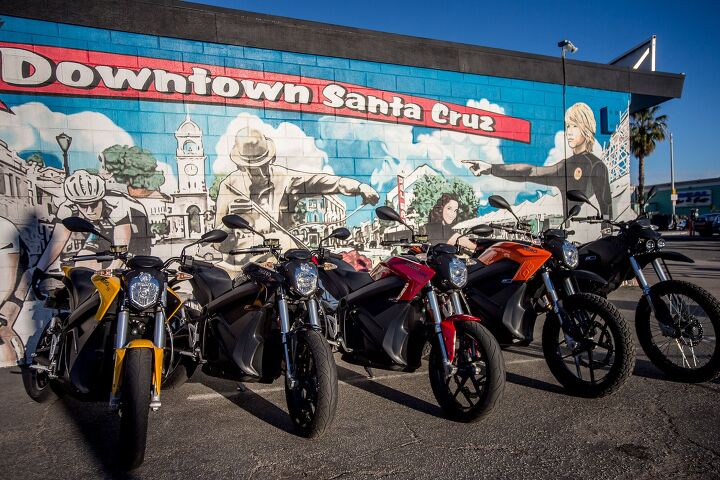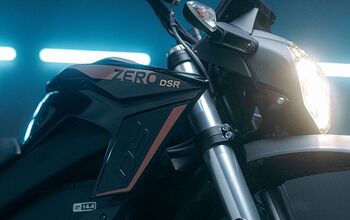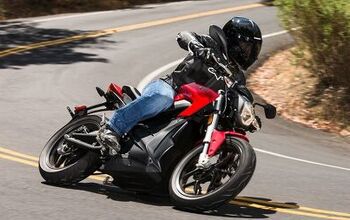2015 Zero New Model Introduction

Riding Zero's Updated Model Line
In 2013, Zero introduced the platforms from which it would build upon for the future. Consisting of what, Zero claims, are the most energy-dense batteries on the market today, its propulsion systems remain quite advanced in the industry. However, off-the-shelf brakes, suspension and tires meant the bikes couldn’t quite reach their full potential. For 2015 however, Zero Motorcycles feels like it has finally come of age.
Leveraging the contacts of Zero’s CTO, Abe Askenazi, who spent 15 years at Buell Motor Company before its demise, Zero forged relationships with companies like Showa, Pirelli, Bosch and J. Juan, and now, those partnerships are finally seeing their way into the 2015 model line. Zero was so enthused by the transformation provided by these components it invited the world’s press to its Santa Cruz, California headquarters to test the entire model range.
While fundamentally the same bikes introduced in 2013, the Zero S, SR, DS and FX see improvements in three key areas. First, all four bikes get an upgrade to Showa suspension. Second, the 2015 Zeros are the first production electric motorcycles to come equipped with ABS, with hardware provided by Bosch and braking components courtesy of J. Juan, a Spanish company with vast experience working with many different OEMs. Lastly, all models will come equipped with Pirelli tires, fitted to redesigned wheels.
The S, SR and DS feature three battery capacity options: the ZF9.4, ZF12.5 and ZF12.5 + Power Tank. These numbers correlate to the battery’s maximum capacity (in the case of the ZF12.5 + Power Tank, max capacity is 15.3 kWh). When measured using the industry standard nominal capacity, this translates to 8.3 kWh, 11.0 kWh and 13.5 kWh. With more juice comes longer range, and Zero claims an S or SR model utilizing the ZF12.5 Power Pack and accessory Power Tank (for a total of 15.3 kWh nominal capacity) could travel up to 185 miles in the city, or 94 miles on the highway at a constant 70 mph.
Below is a breakdown of how each upgrade transforms each individual model. ZF12.5-equipped S and DS models would take us along the twisties en route to the famous Alice’s Restaurant, while SRs fitted with the optional Power Tank, essentially another 2.8 kWh battery, would take us from Alice’s, down the Pacific Coast Highway for a stint, before hitting more curves back to Santa Cruz. FX models logged miles in and around the city to assess how they perform in the day-to-day. Since these aren’t all new models, each bike will get a quick briefing followed by riding impressions with the new updates.
After exactly 70 miles comprised primarily of twisty roads and some cruising along PCH, my SR registered 15% charge remaining. Meanwhile, the other, heavier, members of our group were down to single digits. Unfortunately, the rest of the trip was spent switching between several models, so it was difficult to get accurate range and charge figures. Overall, though, I consistently used less energy than the other members of the test, while keeping the same pace, no matter which model I was riding.
Zero S – $13,345 (ZF9.4), $15,345 (ZF12.5), $17,840 (ZF12.5 + Power Tank)The standard chassis from which the rest of the “monolith” (internal jargon for the S battery pack) series of models are based, the S now sits in the shadows of the hot rod SR. With 54 hp and 68 lb.-ft. of torque from the air-cooled 420-amp motor controller (unchanged from last year), it’s still a capable performer.
Thanks to Showa, the S comes fitted with 41mm inverted cartridge forks, adjustable for spring preload, rebound and compression. In the rear, a Showa monoshock features a 40mm piston, piggyback reservoir and full adjustability just like the front. Rake (24.0º), trail (3.2 in.) and wheelbase (55.5 inches) haven’t changed and neither has suspension travel (6.25 in. and 6.35 in., front and rear, respectively).
What has changed are braking components, as a 320mm wheel-mounted disc replaces the 313mm unit (and its carrier) on the 2014 model. The ABS sensor is cleverly integrated, meaning the ubiquitous speed sensor ring seen on most ABS-equipped bikes is out of sight. A Nissin twin-piston caliper is ditched for a similar J-Juan unit on the 2015 bike, while a single-piston J-Juan caliper grabs a 240mm disc in the rear. Pirelli Sport Demon rubber sits at both ends, the front a 110/70-17, the rear a 140/70-17.
These small but significant changes are instantly noticeable when comparing the 2015 S model to its predecessor. The partnership with Showa especially so, as both ends (but especially the rear) are far more communicative than before. In its standard settings, the ride quality from the shock was too harsh for my taste, especially over some big bumps and potholes. Dialing out a few clicks of compression damping seemed to do the trick for me, though heavier journos on the ride weren’t so lucky. Granted, preload wasn’t set for my colleagues with more, uh… girth. Had they been, these riders admitted they probably would have found a setting to their liking.
Meanwhile, the Sport Demon tires are a definite step above the IRC rubber seen last year. Edge grip was more confidence inspiring, and like the suspension, they seemed better able to communicate than before. As an interesting aside, without any engine noise I could hear the tires rolling on the road and noticed different pitches for different pavement surfaces. Even with earplugs. Braking, too, is a marked improvement. The J. Juan calipers and master cylinder offer great bite, but the big change is in the rear. Gone is the on/off activation and wooden feel from before, replaced with progressive bite you can actually modulate with your foot.
Zero SR – $17,345 (ZF12.5), $19,840 (ZF12.5 + Power Tank)Zero’s latest flagship, the SR, takes the S model and ups the power via a 660-amp motor controller with higher temperature magnets. This results in a horsepower rating of 67 and a Hayabusa-beating 106 lb.-ft of torque. Like the S, the SR gets the same Showa suspension upgrades, ABS, and increased battery capacity as the S model. Pirelli Diablo Rosso II tires replace the Sport Demons on the standard S.
The first (and last) time I rode an SR, my biggest gripes revolved around the shock, low footpegs and mediocre tires. While the pegs and their positioning haven’t changed, the tires and Showa suspension really transform the SR. Its immense torque is of course its central talking point, but with Showa and Pirelli on board, the SR feels like it’s finally capable of reaching its potential.
Our ride on the SR started at the famous Alice’s Restaurant, whipped through the hills and ended at the Pacific Coast Highway at Pescadero. Through it all, the monstrous torque would shoot bike and rider to the next corner while the upgraded tires and suspension instilled confidence in me to rail through them with more aggression than I would have before. Zero claims its bikes aren’t meant to be high-performance sportbikes, but the SR is pretty damn close.
Zero DS – $13,345 (ZF9.4), $15,345 (ZF12.5), $17,840 (ZF12.5 + Power Tank)Essentially a Zero S chassis, the DS version comes with wider bars, longer travel suspension (7.00 in./7.03 in. front/rear vs. 6.25 in./6.35in. on S model), and Pirelli MT-60 rubber mounted on a 19-inch front and 17-inch rear. Power delivery is linear and smooth, just like the other models. However, where the bigger journos on the test were getting jarred by the S model’s suspension, the extra travel afforded by the DS made it their bike of choice, especially when the roads were particularly bumpy. Actual time in the dirt was virtually non-existent save for a quick pass by the photographers on a dirty, broken asphalt road, so its off-road worthiness will have to wait until we get one in our hands for a full test.
What I can say is that the wider bars (compared to the S) not only provide more leverage, but also give the feeling of more roominess in the cockpit since the arms are opened up just a smidge. It’s a sentiment other testers noted as well.
Zero FX – $9,845 (ZF2.8), $12,340 (ZF5.7)Zero reps say, in 2014, the company doubled its sales over the year before, and believe it or not, the FX was Zero’s best selling model (we’d like to give at least some of the credit to our 2014 Zero FX dirt review). Despite this, it doesn’t receive the range improvements its S, SR and DS siblings see for 2015. For the FX, this means a claimed maximum range of 70 city miles. Still, like the rest of the Zero line, fully adjustable Showa suspension, Bosch ABS, J. Juan brake components and Pirelli tires are mounted for the first time. Specifically, the FX comes fitted with Pirelli Scorpion MT 90 rubber.
Combined with its relatively light 289 lbs. and 70 lb.-ft. of torque, the FX makes a great bike when slicing through the city or playing in the dirt is what you’re after. Its 8.6-inch and 8.9-inch suspension travel front and rear, respectively, soak up crappy roads while also giving a commanding view, thanks to its 34.7-inch seat height. With enough pep to loft the front tire off the ground, it’s best to respect the FX’s power.
The FX will easily leave the cars at the light behind, and its narrow, dirtbike stature is ideal for filtering through lanes or maneuvering through tight situations. My time with the FX was limited to simply exploring Zero’s home town of Santa Cruz, but immediately I noticed rear suspension compliance was much improved over the Fast Ace unit used on its predecessor (the Fast Ace fork wasn’t so bad, actually). It’s difficult to tell without testing each piece individually, but the shock and Pirelli MT 90 combination communicated what the rear tire was doing more effectively than before.
As for the J. Juan brakes, lever feel is progressive with a decent initial bite and power that ramps up the harder you squeeze. With the skinny 90/90-21 front tire (120/80-21 rear), I was thankful for the Bosch ABS, as coming around a blind corner only to see a stopped car immediately in front triggered a panic stop reaction while leaned over. I actually heard the tires chirp for a moment before ABS kicked in, saving my bacon. As noted above, rear brake power and feel is a giant step ahead of its predecessor.
The FX’s wide bars aren’t changed for 2015, but the leverage they provide makes it supremely easy to throw the bike wherever you want it. This is good since, at slow speeds, the FX will turn in easily but requires more pressure from the bars to complete the arc. This isn’t an issue once rolling at higher speeds.
While we didn’t do any off-roading with the 2015 FX, we’ve spent plenty of time with its predecessor in the dirt, as witnessed in the 2014 dirt review above, and E-i-C Kevin Duke’s column. We were pleasantly surprised with the bike back then and see no reason why it won’t be equally as impressive now. From our short time cruising around Santa Cruz, it’s clear the evolution of the FX has put it a step ahead of last year.
ConclusionIt’s amazing what improvements like better suspension, tires, brakes and the addition of ABS will do to a bike. With battery technology advancing at an incredible pace, the sky is the limit as far as future potential. In the case of the 2015 Zero lineup, we’re no longer waiting for electrics to finally make it. All we’re waiting on is for prices to come down – a topic Zero execs are well aware is the number one complaint among many. Put price aside for a moment and judge on performance. In that sense, thanks in large part to Zero, the electric motorcycle has arrived.

Troy's been riding motorcycles and writing about them since 2006, getting his start at Rider Magazine. From there, he moved to Sport Rider Magazine before finally landing at Motorcycle.com in 2011. A lifelong gearhead who didn't fully immerse himself in motorcycles until his teenage years, Troy's interests have always been in technology, performance, and going fast. Naturally, racing was the perfect avenue to combine all three. Troy has been racing nearly as long as he's been riding and has competed at the AMA national level. He's also won multiple club races throughout the country, culminating in a Utah Sport Bike Association championship in 2011. He has been invited as a guest instructor for the Yamaha Champions Riding School, and when he's not out riding, he's either wrenching on bikes or watching MotoGP.
More by Troy Siahaan







































Comments
Join the conversation
Well Polaris, you wanted to jump waist deep into the electro-biker wars...Meet your competition :)
Have you guys ever done a Brammo vs Zero comparo?
Nice wrap-up, thanks Troy.
The FX looks amazing - not just because it's electric, but because it's an everyday high-performance dual sport with ABS, making it the perfect weekday city screamer for the wet and windy area I live in. But that ABS might be a handicap when it's time to get dirty on the weekend, so I'm wondering if it's switchable or better yet has a KTM-style off-road mode?